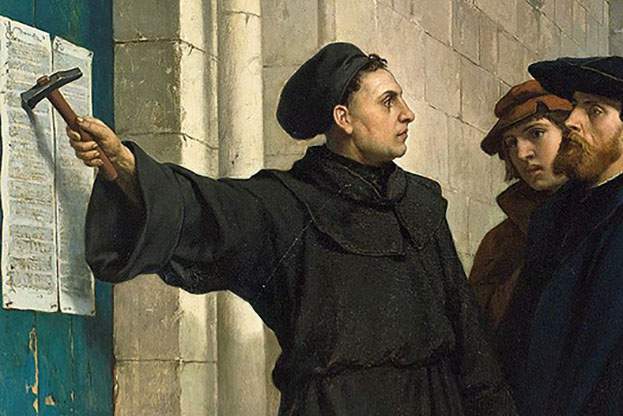
“A mighty fortress is our God,” reads the text of a popular English-language translation of Luther’s classic hymn, “a bulwark never failing.” Martin Luther was a great fan of music, and on Harmonia this hour, in honor of the 500th anniversary of the Reformation, we’re exploring Lutheran composers. Our featured release is the 2016 Capella de Ministrers recording, The Last Pilgrimage.
We heard Johann Sebastian Bach’s setting of the Lutheran chorale “Nun danket alle Gott,” from the Leipzig chorales, performed by Fenner Douglass on the Flentrop organ of Duke University Chapel in Durham, North Carolina. That organ, like many other historically-informed instruments, was carefully built to mimic the style and sound of the organs that Bach himself would’ve played, way back in the 18th century. Can you imagine Bach himself playing this piece on this organ?
Luther's Declaration
It was October 31st, 1517, when Martin Luther mailed his Ninety-five Theses to Albert of Brandenburg, the Archbishop of Mainz - a date that Lutherans all over the world now commemorate as Reformation Day. At the time, this was a really big deal. Luther, who was a professor of theology, a composer, and a monk, was making a radical move by coming out so virulently, and so publicly, against some very common, publicly accepted church practices. In doing so, he altered the path of organized religion in the Western Christian church in a big, big way. No small feat for a guy who was, after all, just one man.
Martin Luther loved music. He was a prolific writer, and the subject of music came up frequently in his many letters and articles. Clearly, he was firmly in favor of it. In addition, he was a composer himself, credited with many tunes and texts, quite a few of which are still frequently heard sung in churches today.
Not surprisingly, soon after the beginning of the Lutheran Reformation, music that we would now call “Lutheran music” began to appear on the scene. Michael Praetorius, who was born in 1571, less than thirty years after Luther’s death, was the youngest son of a Lutheran pastor. He’s especially well remembered for his harmonization of the tune Es ist ein Ros entsprungen, which was written in 1609. This familiar hymn has been recorded, using Praetorius’s harmonization, by everyone from the Trapp Family Singers to Los Romeros to The King’s Singers. We’ll hear a performance by soprano Faye Newton, from the recording Music for the Twelve Days of Christmas.
We heard soprano Faye Newton, from the recording Music for the Twelve Days of Christmas.
Michael Praetorius, like most composers of his day, was first and foremost a working musician. Like many prolific composers, he worked a “day job,” serving as a church organist, and a great deal of his sacred music was intended for performance as part of the worship service. We’ll hear some of that music now, the third and fourth parts of Michael Praetorius’s setting of Mary’s song, the Magnificat.
We heard Apollo’s Fire, with guest soloists, under the direction of Jeannette Sorrell, from the recording Christmas Vespers: Music of Michael Praetorius.
Bach's Ein feste Burg
Mirror, mirror, on the wall, who’s the most famous Lutheran church musician of them all? Why, J. S. Bach, of course! Arguably one of the most famous composers ever, Johann Sebastian Bach was, like Michael Praetorius before him, both a prolific composer and a working church musician.
Over his decades of life in the church, he wrote a huge amount of music intended for performance as a part of the worship service, including more than 200 cantatas. We’ll hear one of those cantatas now, number 80, Bach’s setting of Luther’s stirring tune, Ein feste Burg ist unser Gott. We’ll listen to the recording from volume 5 of Nikolaus Harnoncourt and Gustav Leonhardt’s groundbreaking set.
We heard the first four movements of J. S. Bach’s sacred cantata number 80, Ein feste Burg ist unser Gott, as performed by Nikolaus Harnoncourt, Gustav Leonhardt, and friends.
Bach's Ein feste Burg, continued
Welcome back. We’ve been listening to Johann Sebastian Bach’s sacred cantata number 80, Ein feste Burg ist unser Gott, from the groundbreaking series of recordings masterminded by Nikolaus Harnoncourt and Gustav Leonhardt. We’ll jump back in with the fifth movement, the chorus “Und wenn die Welt voll Teufel wär.”
We heard the last four movements of J. S. Bach’s sacred cantata number 80, Ein feste Burg ist unser Gott, as performed by Nikolaus Harnoncourt, Gustav Leonhardt, and an ensemble of friends and family.
Ramon Llull: The Last Pilgrimage
On our featured release, the 2016 Capella de Ministrers recording The Last Pilgrimage, we explore music related to the life, work, and travels of the medieval Catalan philosopher Ramon Llull. This three-disc set, from the Spanish early music ensemble Capella de Ministrers, runs nearly three and a half hours, and features an incredibly wide variety of styles and sounds.
We heard music from the 2016 Capella de Ministrers recording, The Last Pilgrimage.
Break and theme music
:30, Christmas Vespers: Music of Michael Praetorius, Michael Sponseller, organ, Avie 2015, Tr. 17 Nun lob mein Seel
:60, O Sacrum Convivium, David J. Smith, organ, Odradek 2016, Tr. 10 Fugue on the Magnificat
:30, The Last Pilgrimage, Capella de Ministrers, CDM 2016, Disc 2, Tr. 1 La quinte estampie real
Theme: Danse Royale, Ensemble Alcatraz, Elektra Nonesuch 79240-2 1992 B000005J0B, Tr. 12 La Prime Estampie Royal
The writers for this edition of Harmonia was Elizabeth Clark.
Learn more about recent early music CDs on the Harmonia Early Music Podcast. You can subscribe on iTunes or at http://www.harmoniaearlymusic.org.









